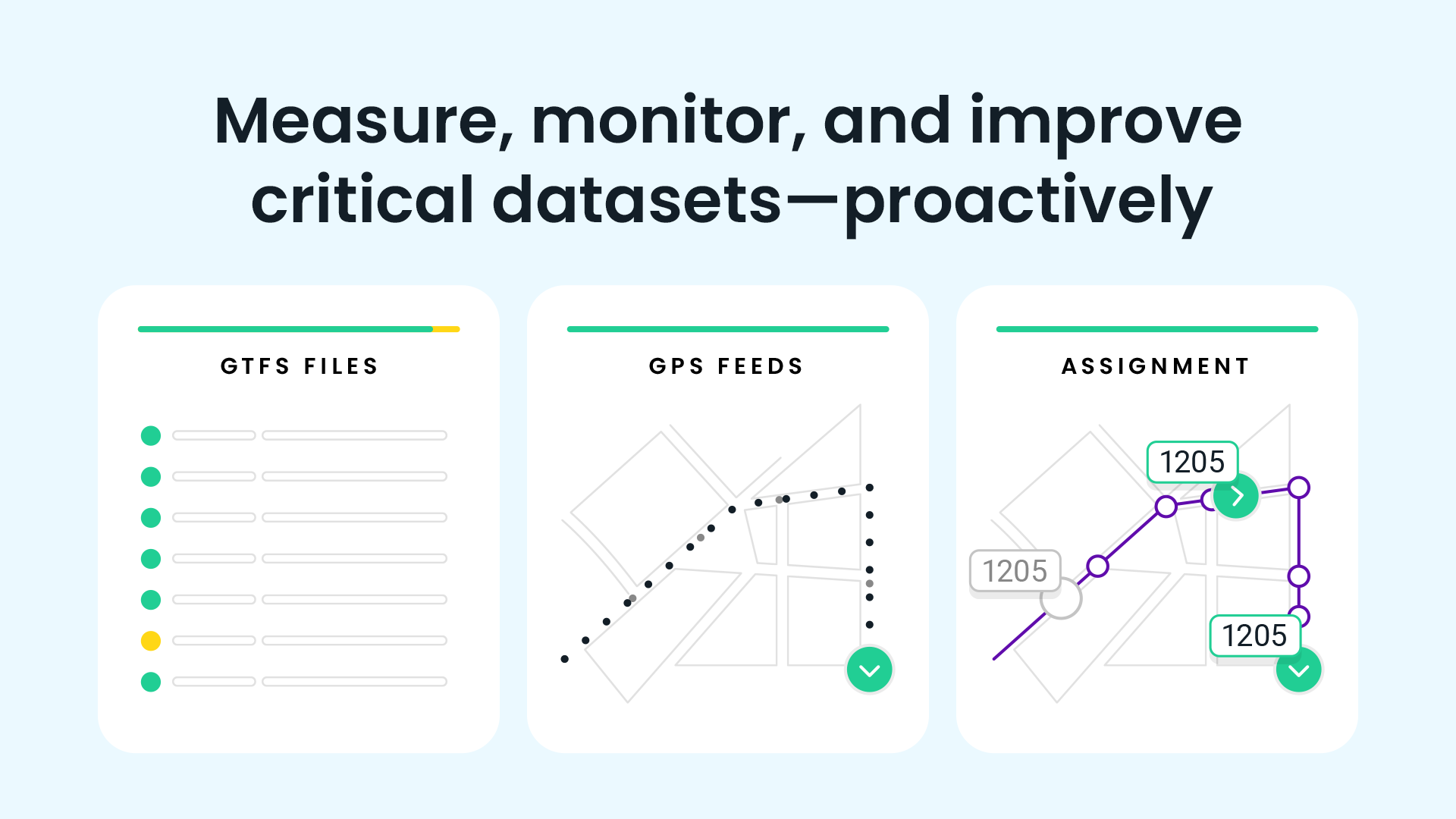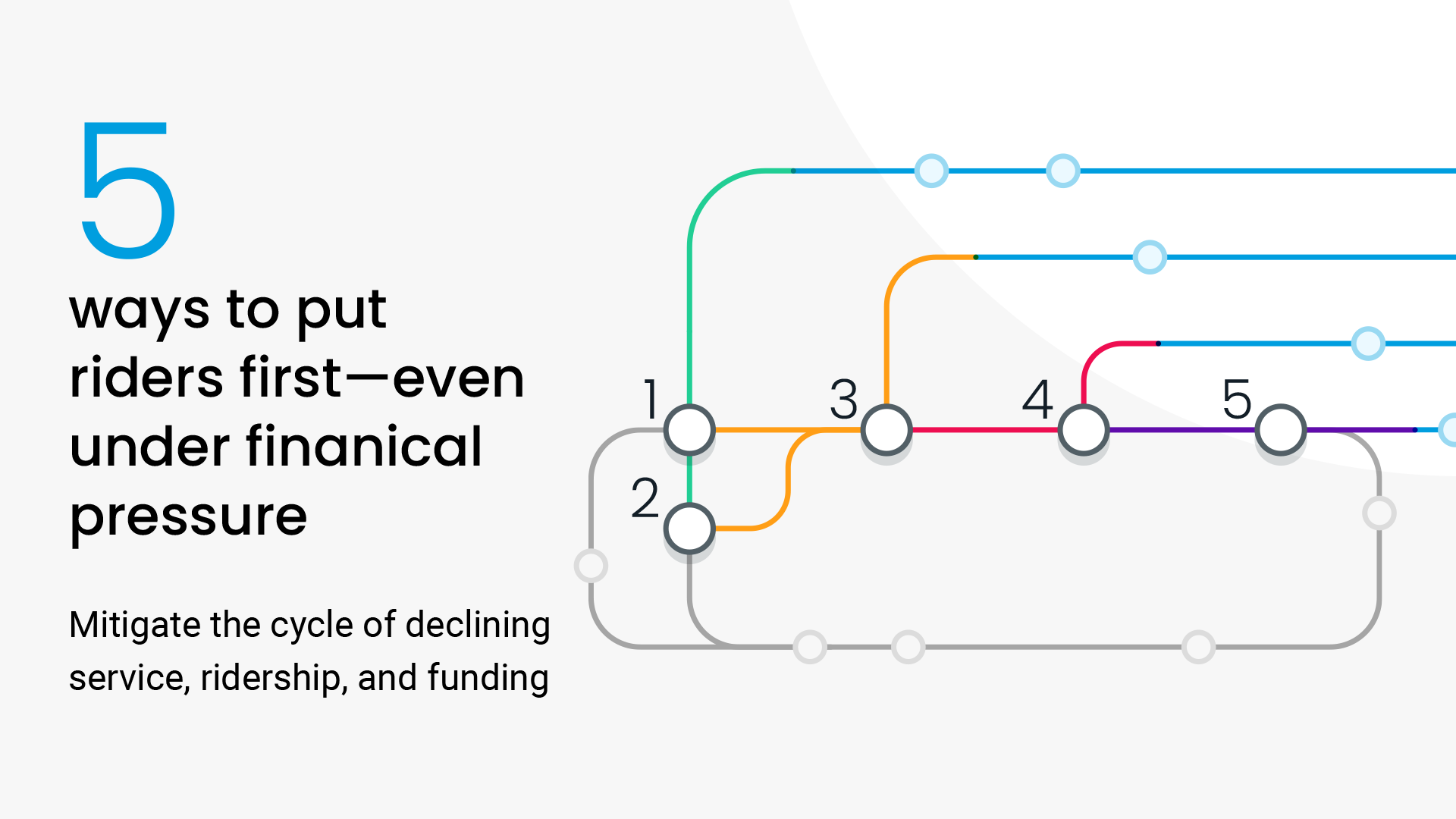
June 13, 2023
Defining success in real-time passenger information: Seven factors to measure

June 13, 2023
Defining success in real-time passenger information: Seven factors to measure
June 13, 2023
Defining success in real-time passenger information: Seven factors to measure
As agencies look to grow ridership post pandemic, numerous studies have shown that real-time passenger information (RTPI) is one of the most impactful ways to bring riders back. Year after year, studies report that accurate passenger information is the most important factor in increasing transit ridership.
Multiple academic reports have shown that accurate real-time information has several benefits for riders:
- Decreased actual & perceived wait times
- Reductions in overall travel time due to changes in path choice
- Increased use of transit
But how do we define “good” real-time passenger information?
In the absence of industry standards or publicly available analysis of all transit systems, it can be difficult for agencies to benchmark the quality of their real-time information or even know which areas of investment will have the greatest impact.
Furthermore, many areas of system performance can be out of an agency’s direct control. Striving for the best prediction accuracy possible is important, but the exact outcome can depend on a host of factors including traffic, funding, workforce resources, natural disasters, and other service disruptions.
With this article, we want to outline the factors an agency controls that result in “best-in-class” passenger information.
Working with over 145 agencies, we’ve identified best practices across the different variables that influence real-time passenger information. By focusing on these areas, agencies can ensure a positive impact on the rider experience.
Read on for guidance on how to evaluate your agency's real-time passenger information. Interested in receiving an analysis of your agency's existing data? Fill out the form below for a consultation with a Swiftly transit data expert.
Request a demo
A framework for effective real-time passenger information
As we think about delivering a world class rider experience through more accurate data, we often consider two key principles:
1. Consistent information across all channels
- Riders access information across many different channels – mobile apps like Transit, Google Maps, and Apple Maps, on street signage, SMS, IVR, agency websites, and more. It’s important that we meet riders where they are and that the information presented is consistent. When riders receive inconsistent information, such as different arrival times across a mobile app and an on-street sign, they lose trust in that moment and in the future.
2. Accurate, up-to-date information
- Information not only needs to be consistent, but accurate as well. This includes everything from the AVL quality, arrival time accuracy, ability to communicate detours and service cancellations, and more.
Within this broader framework, the following seven factors are critical to laying the foundation for excellent real-time passenger information.

Vehicle location reporting rate and latency
Riders today expect to see vehicles move in real-time on maps, influenced by consumer ride-hailing apps. Achieving this confidence-inspiring real-time location requires vehicles that report location every few seconds. Ultimately, the more frequently a vehicle shares its location data with a real-time passenger information system, the more accurate arrival predictions will be.
It’s important to note that legacy software systems can create a delay, or latency, in the time it takes for GPS data to transmit from vehicle hardware into real-time applications. Agencies do not always measure latency, but it can significantly reduce effective location reporting rates.
Swiftly can often leverage existing infrastructure to dramatically improve reporting rates and reduce latency. We do this by combining multiple GPS feeds from existing onboard systems such as routers, security cameras, and more in real-time.
Vehicle assignment rate and accuracy
Knowing which vehicle is assigned to a route is critical for accurate passenger information. While ghost buses today have recently become associated with canceled service, an incorrectly assigned vehicle can also confuse passengers by either failing to arrive at a stop or showing up unannounced.
Agencies often struggle with inaccurate assignment in situations where operators forget to log in, or incorrectly log in, to a Mobile Data Terminal (MDT). If an agency does not have a CAD/AVL system, then vehicle assignments may not exist altogether. Swiftly's data engine can automatically assign vehicles to correct routes, trips, blocks, and runs to prevent missed arrival predictions.
Channels of RTPI data
Agencies leading the way on the passenger experience talk about meeting riders where they are with real-time information. Millions of riders nationwide rely on popular third-party apps like Transit, Google Maps, and Apple Maps. Requiring riders to download an agency’s proprietary app or visit an agency’s website creates an additional layer of friction to accessing real-time passenger information. Making passenger information available in a GTFS-rt format ensures consistent real-time information across third-party apps, SMS systems, interactive voice response (IVR) systems, and electronic signage.
You can watch our recent webinar with Santa Monica’s Big Blue Bus to learn how their customer experience team keeps passengers informed across all channels of real-time passenger information.
Time to answer "Where's my bus?" calls
Many riders rely on agency call centers for queries or complaints. Legacy systems can make it difficult for customer service representatives to access information about where a bus is or has been. With Swiftly, agency staff receive unlimited dashboard logins and can access information on past or present bus location in under one minute. Across thousands of calls, a savings of a few minutes per call can mean saving hundreds or thousands of hours of staff time per year.
Real-time crowding information
Riders today expect to have information on crowding conditions along with real-time arrival predictions - whether for comfort or health and safety reasons. Passenger count data should already exist within CAD/AVL systems or standalone Automated Passenger Counting solutions, but agencies must ensure this data is made available in third-party trip planning apps. RTA Maryland, for example, makes crowding information from Automated Passenger Counters (APCs) available to the public through their GTFS-rt feed.
Service-adjustment-aware predictions
In the wake of staffing shortages, ghost buses stemming from canceled service have plagued transit agencies across the country, leaving riders waiting at the curb and grabbing headlines. Failing to update predictions with service adjustments for canceled or detoured service causes ride-planning apps to default to schedule-based predictions, resulting in the dreaded ghost bus phenomenon.
Yet these incidents are preventable if agency staff are empowered with the tools to communicate service adjustments.
Best-in-class real-time passenger information includes more than just accurate arrival predictions. This should include the ability to cancel and add service, as well as create detours with arrival predictions for new stops. For example, when an agency does not have enough operators to meet scheduled service, they may delete existing trips and add new trips with greater headways.
Agencies used Swiftly to inform riders of thousands of service adjustments during storms this past winter.
Contextual rider alerts
Significant, recurring, or planned service disruptions can benefit from additional information beyond updated arrival times. Riders obviously want to know that the bus won’t be coming, but they also want to know why, as well as how long service will be affected.
Agencies should incorporate rider alerts along with ETAs to provide additional context - the cause for canceled service, the duration of a detour, etc. For example, in addition to updating stops and scheduled arrival times for a two-week detour, an agency could post a rider alert explaining that planned construction has forced buses to use another street and the detour will last for two weeks.
Alerts should be incorporated in an agency’s GTFS-rt feed so they become visible in third-party apps. With Swiftly, agencies like San Diego’s North County Transit District automatically publish rider alerts to their GTFS-rt feed when they create service adjustments.
Moving on to accuracy
Together, these variables contribute to the consistency of real-time passenger information. Delivering excellent coverage means that real-time data is available from all vehicles. Availability requires that data can be easily accessed by passengers and staff.
The remaining element of excellent real-time passenger information is accuracy. In a future post, we will outline how agencies can evaluate the accuracy of arrival predictions to ensure the best possible rider experience and drive increased ridership.
The rich text element allows you to create and format headings, paragraphs, blockquotes, images, and video all in one place instead of having to add and format them individually. Just double-click and easily create content.
Last Name, Agency

What’s a Rich Text element?
What’s a Rich Text element?
What’s a Rich Text element?
What’s a Rich Text element?
What’s a Rich Text element?
The rich text element allows you to create and format headings, paragraphs, blockquotes, images, and video all in one place instead of having to add and format them individually. Just double-click and easily create content.
Last Name, Agency
Static and dynamic content editing
A rich text element can be used with static or dynamic content. For static content, just drop it into any page and begin editing. For dynamic content, add a rich text field to any collection and then connect a rich text element to that field in the settings panel. Voila!
How to customize formatting for each rich text
Headings, paragraphs, blockquotes, figures, images, and figure captions can all be styled after a class is added to the rich text element using the "When inside of" nested selector system.
- text goes here
- text goes here
- text goes here
- text goes here
- text goes here
- text goes here









